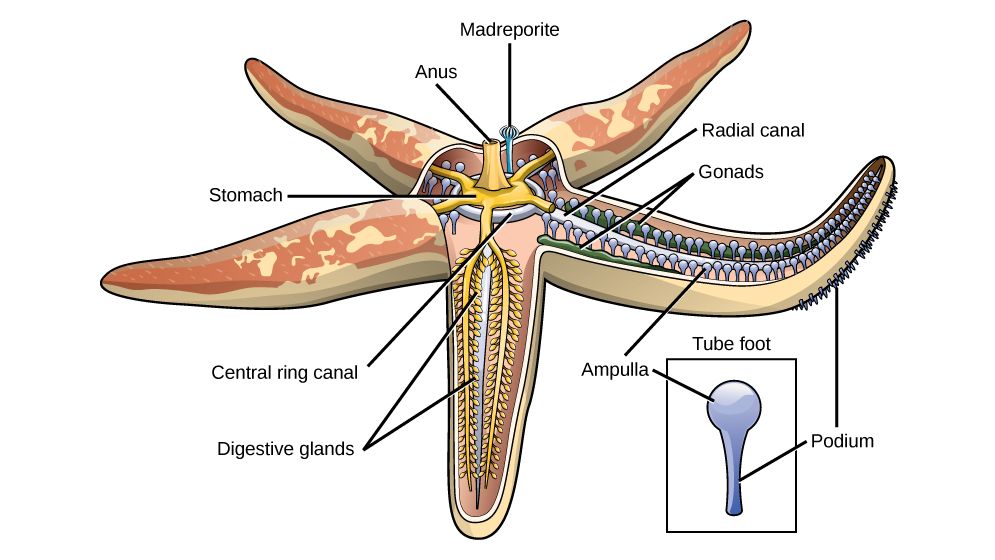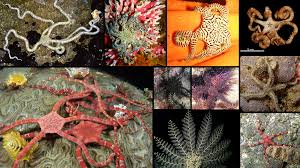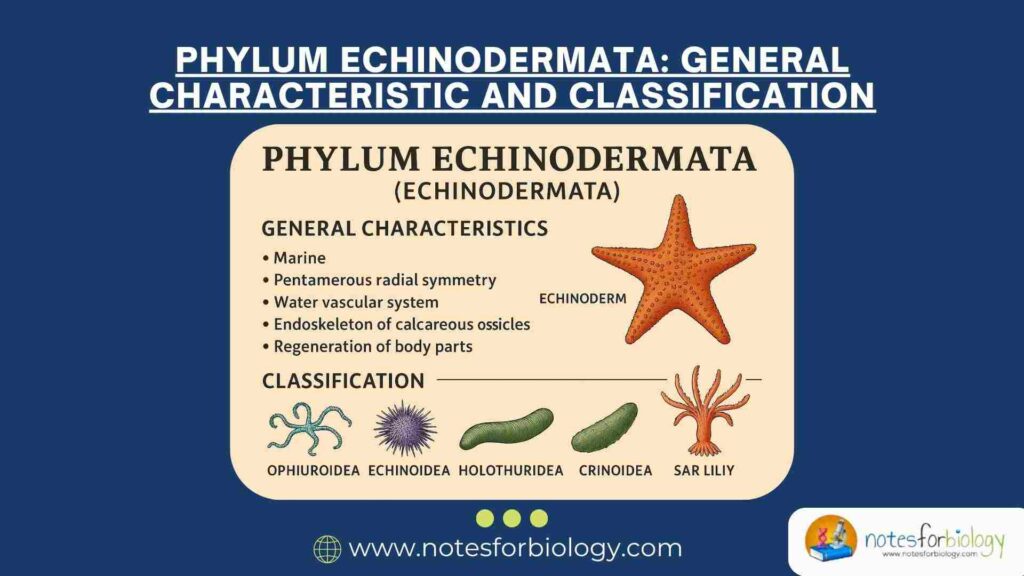Phylum Echinodermata is a distinct and well-defined group of exclusively marine animals recognized for their unique anatomical and physiological features. The term “Echinodermata” is derived from the Greek words echinos, meaning spiny, and derma, meaning skin collectively referring to their characteristic spiny or rough external covering. These organisms are particularly fascinating due to their radial symmetry in adulthood, water vascular system, calcareous endoskeleton, and remarkable regenerative abilities.
Echinoderms occupy a wide range of marine habitats from shallow coastal waters to the deep sea. This phylum includes familiar sea creatures such as starfish, sea urchins, brittle stars, sea cucumbers, and sea lilies. This article offers a comprehensive explanation of the general characteristics of Phylum Echinodermata, followed by their detailed classification.
Summary of Echinodermata
- Echinoderms are exclusively marine animals with radial symmetry in adults and a unique water vascular system for movement and feeding.
- They have a calcareous endoskeleton made of ossicles and remarkable regenerative abilities.
- The phylum includes starfish, sea urchins, brittle stars, sea cucumbers, and sea lilies, classified into five main classes.
Table of Contents
General Characteristics of Phylum Echinodermata
Habitat
Members of Phylum Echinodermata are exclusively marine organisms. They inhabit various marine environments, ranging from shallow intertidal zones to the abyssal depths of the ocean. No representative of this phylum is found in freshwater or terrestrial ecosystems.
Body Organization
The body of Phylum Echinodermata lacks a distinct head and is generally organized into a central disc with arms or radiating parts. The body is unsegmented and may be star-shaped, spherical, elongated, or cylindrical, depending on the group.
Endoskeleton
Echinoderms possess an internal skeleton made up of calcareous ossicles embedded within the dermis. These ossicles often bear spines, tubercles, or plates, contributing to the animal’s external texture. The endoskeleton provides structural support and protection to the soft internal organs.
Body Wall
The body wall consists of a multi-layered dermis covered by a thin epidermis. Embedded within the dermis are calcareous plates or ossicles, and in some cases, defensive spines. The outer surface may also bear pedicellariae, small pincer-like appendages used for cleaning and defense.
Coelom
Echinoderms are coelomate animals, possessing a true coelom derived from the embryonic mesoderm. The coelomic cavity is spacious and serves as a hydrostatic skeleton, assisting in locomotion and the circulation of nutrients and gases.
Digestive System
The digestive system of Phylum Echinodermata is complete in most forms, consisting of a mouth, esophagus, stomach, intestine, and anus. However, variations exist among different classes. Some species, like brittle stars, lack an anus, and waste products are expelled through the mouth.
Circulatory System
A poorly developed circulatory system is present in echinoderms. It comprises a hemal system and coelomic fluid circulation. The hemal system consists of sinuses and vessels, while the coelomic fluid transports nutrients, respiratory gases, and waste products.
Respiratory Structures
Respiration in echinoderms occurs through various structures depending on the species. These include dermal branchiae (skin gills), tube feet, peristomial gills, and cloacal respiratory trees in sea cucumbers.
Excretory System
An excretory system with specialized excretory organs is absent in echinoderms. Waste products, primarily ammonia, diffuse out through body surfaces such as tube feet, dermal gills, and cloacal openings.
Nervous System
Echinoderms possess a decentralized and simple nervous system without a true brain. A nerve ring encircles the mouth, from which radial nerves extend into the arms or body regions. Sensory cells are scattered throughout the body wall.
Reproductive System
Most echinoderms are dioecious, having separate male and female individuals, although some hermaphroditic species exist. Fertilization is generally external, occurring in the surrounding water. Development involves free-swimming, bilaterally symmetrical larvae, which undergo metamorphosis into radially symmetrical adults.
Regeneration
Echinoderms are renowned for their remarkable regenerative abilities. They can regenerate lost arms, spines, or even entire body parts under suitable conditions, an ability that plays a vital role in their survival and ecological success.
Classification of Phylum Echinodermata
The phylum Echinodermata is traditionally classified into five main classes based on body structure, presence or absence of arms, type of skeleton, and specific anatomical adaptations.
Class Asteroidea

This class includes the well-known starfish or sea stars. Members of Asteroidea have a star-shaped body with a central disc and five or more radiating arms. The body is flattened dorsoventrally, and the mouth is located on the underside (oral surface). The aboral surface often bears dermal branchiae and spines. Starfish are predatory or scavenging organisms, feeding on mollusks and other invertebrates. Examples include Asterias and Oreaster.
Class Ophiuroidea

Commonly referred to as brittle stars or serpent stars, members of this class have a central disc distinct from the slender, flexible arms. These arms lack ambulacral grooves and move in a snake-like fashion. Brittle stars are primarily detritivores and suspension feeders. They exhibit greater arm mobility than other echinoderms. Representative genera include Ophiura and Ophiothrix.
Class Echinoidea

Echinoidea includes sea urchins, heart urchins, and sand dollars. These echinoderms have a globular or flattened, spherical body enclosed within a rigid calcareous test made up of fused ossicles. Spines of varying lengths cover the body, and tube feet protrude through pores in the test. A specialized feeding apparatus called Aristotle’s lantern is present in most species. Notable examples are Echinus and Clypeaster.
Class Holothuroidea
Sea cucumbers are included in this class. Their bodies are elongated, cylindrical, and lack arms. The skeleton is reduced to microscopic ossicles embedded in the body wall, giving them a soft texture. Holothuroideans possess tentacle-like tube feet around the mouth, used for feeding. Some species possess unique respiratory trees connected to the cloaca. Examples include Holothuria and Cucumaria.
Class Crinoidea
Crinoids, commonly known as sea lilies and feather stars, belong to this ancient class. Their body is cup-shaped with numerous feathery, branched arms used for filter feeding. Sea lilies are typically stalked and attached to the substrate, while feather stars are free-swimming. The mouth and anus are both located on the upper (oral) surface. Examples include Antedon and Pentacrinus.
Symmetry in Echinodermata
The phylum Echinodermata includes marine animals such as starfish, sea urchins, brittle stars, sea cucumbers, and sea lilies. These animals exhibit a unique pattern of symmetry during their life cycle, which changes from one stage to another.
Bilateral Symmetry in Larvae
In the larval stage, echinoderms show bilateral symmetry. This means that the larval body can be divided into two equal halves along a single plane. This form of symmetry is typical in most animal groups and allows for directed movement in water, with distinct anterior (front) and posterior (rear) ends.
Radial Symmetry in Adults
As they undergo metamorphosis into adults, echinoderms develop radial symmetry. In this form, the body parts are arranged around a central axis, like the spokes of a wheel. Most adult echinoderms show pentaradial symmetry, where the body is organized into five (or multiples of five) repeating segments radiating from the center.
For example:
- A starfish typically has five arms arranged around a central disc.
- A sea urchin has body parts arranged in five equal sections around its spherical body.
Reproduction and Development of Echinodermata
Modes of Reproduction
Echinoderms exhibit both asexual and sexual modes of reproduction, though sexual reproduction is predominant.
Asexual Reproduction
Some echinoderms, such as certain species of starfish and brittle stars, can reproduce asexually by regeneration and fragmentation. A part of the body, such as an arm with a portion of the central disc, can develop into a new individual under favorable conditions.
Sexual Reproduction
Most echinoderms are dioecious, meaning male and female individuals are separate. A few species are hermaphroditic. The sexes typically release gametes into the water for external fertilization. Echinoderms produce large quantities of eggs and sperm to increase the chances of successful fertilization.
Gonads and Gametes
Echinoderms possess simple gonads that produce eggs or sperm. The number and location of gonads vary among classes:
- Starfish and brittle stars have multiple gonads in each arm.
- Sea urchins and sea cucumbers generally have a single gonad.
The gametes are released through specialized openings called gonopores, leading to external fertilization in the surrounding seawater.
Fertilization and Larval Development
Fertilization occurs externally in seawater. The zygote undergoes radial, holoblastic cleavage, followed by the formation of a blastula and then a gastrula.
Larval Stages
Echinoderm development includes several distinct larval stages, which are bilaterally symmetrical, unlike the radially symmetrical adults.
- Starfish develop a bipinnaria larva followed by a brachiolaria.
- Sea urchins and sand dollars have a pluteus larva.
- Brittle stars also develop an ophiopluteus.
- Sea cucumbers form an auricularia larva.
These larvae are free-swimming and planktonic, undergoing metamorphosis to form the adult, radially symmetrical form.
Metamorphosis
During metamorphosis, the bilateral larvae settle onto a substrate and reorganize their body plan into the adult form. The larval mouth and anus disappear, and new structures appropriate for the adult body plan develop.
Mechanism of Locomotion
Locomotion in echinoderms is primarily achieved through the hydraulic action of the tube feet.
When the ampulla contracts, it pushes water into the tube foot, elongating it. The tube foot attaches to a substrate using suction created by adhesive secretions. Subsequently, contraction of the longitudinal muscles within the tube foot pulls the body forward. Coordinated extension and retraction of multiple tube feet enable the animal to move.
Different echinoderm classes display variations in locomotion:
- Starfish (Asteroidea) move slowly using hundreds of tube feet on their undersides.
- Sea urchins (Echinoidea) use both tube feet and spines for movement.
- Brittle stars (Ophiuroidea) primarily use arm movement rather than tube feet.
- Sea cucumbers (Holothuroidea) rely on the tube feet and body wall muscles.
- Feather stars (Crinoidea) use their arms for crawling or swimming.
Ecological and Economic Importance of Echinodermata
Ecological Importance
Echinoderms play significant roles in marine ecosystems.
Benthic Community Members
As benthic animals, echinoderms are important members of ocean floor communities. They contribute to the structure and function of marine habitats.
Bioturbation and Sediment Mixing
Burrowing echinoderms, such as sea cucumbers and heart urchins, help aerate the seabed and mix sediments, promoting nutrient cycling and the health of benthic ecosystems.
Predator-Prey Dynamics
Echinoderms are both predators and prey in marine food webs. Starfish, for instance, prey on mollusks and other invertebrates, while many echinoderms serve as food for fish, crabs, and sea birds.
Algal Grazing
Sea urchins play a crucial role in controlling algal growth on reefs and rocky substrates, preventing algal overgrowth and maintaining ecological balance.
Coral Reef Ecosystems
Some echinoderms, like the crown-of-thorns starfish, can have both positive and negative effects on coral reefs. While moderate numbers help control coral competitors, outbreaks can devastate coral populations.
Economic Importance
Echinoderms have both direct and indirect economic significance to humans.
Fisheries and Edible Species
Certain echinoderms are harvested for food. Sea cucumbers (trepang or bêche-de-mer) are considered a delicacy in East Asian cuisine. Sea urchin gonads (roe) are also highly prized in some culinary traditions.
Ecotourism and Recreation
Echinoderms add aesthetic and ecological value to marine environments, attracting tourists for snorkeling and diving. Colorful starfish and sea urchins are commonly featured in marine exhibits.
Pharmaceutical and Biomedical Research
Echinoderms are valuable model organisms in developmental biology, regenerative medicine, and immunology. Their simple body plan and unique regenerative abilities provide insights into tissue regeneration and embryonic development.
Source of Bioactive Compounds
Various bioactive compounds, including saponins, lectins, and steroids, have been extracted from echinoderms for pharmaceutical applications, such as anti-cancer, anti-inflammatory, and antimicrobial agents.
Environmental Indicators
Due to their sensitivity to environmental changes, echinoderms are used as bioindicators for monitoring the health of marine ecosystems and detecting pollution or climate-related shifts.
Conclusion
Phylum Echinodermata represents a fascinating group of exclusively marine invertebrates known for their radial symmetry, calcareous endoskeleton, water vascular system, and impressive regenerative capabilities. The phylum’s unique structural and functional attributes make it distinct among animal groups, offering valuable insights into evolutionary biology, marine ecology, and developmental processes. Through its well-defined classes — Asteroidea, Ophiuroidea, Echinoidea, Holothuroidea, and Crinoidea , Echinodermata exhibits remarkable diversity and ecological adaptability, underscoring its significance in marine ecosystems.
Frequently Asked Questions (FAQ)
Are phylum Echinodermata protostomes?
No, phylum Echinodermata are deuterostomes, meaning during embryonic development, the anus forms before the mouth. This groups them closer to chordates (like vertebrates) rather than protostomes.
How do phylum Echinodermata reproduce?
Echinoderms primarily reproduce sexually through external fertilization, where males and females release sperm and eggs into the water. Some species can also reproduce asexually by regeneration or fragmentation.
Where do phylum Echinodermata live?
Echinoderms are exclusively marine animals and are found in oceans worldwide, from shallow coastal waters to deep sea environments.
Related Contents
Phylum Annelida: General Characteristics and Classification
Phylum Cnidaria/Coelenterata: General Characteristic and Classification




